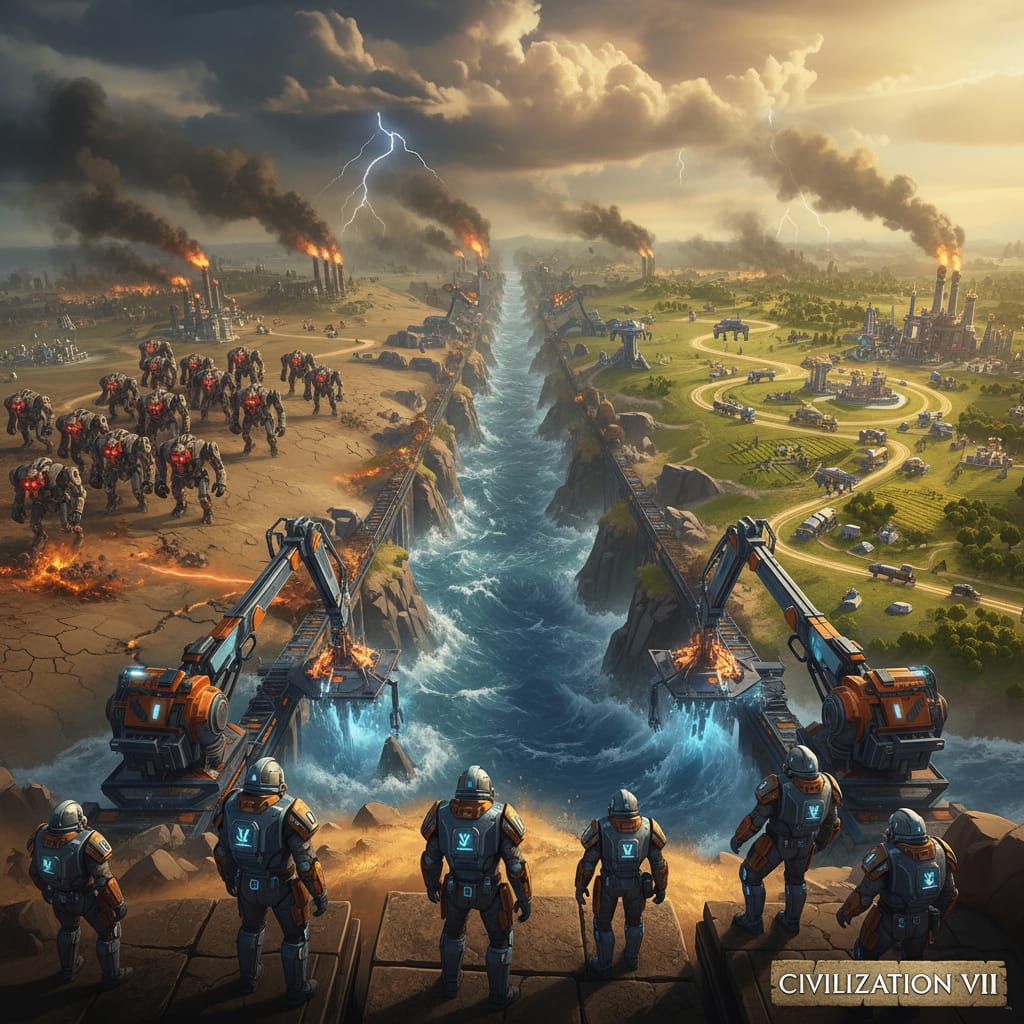In the grand tapestry of Civilization VI, geography is destiny. The shape of the world, the placement of its continents, and the vastness of its oceans dictate the flow of history, the clash of armies, and the spread of empires. For millennia, the sea has been both a barrier and a gateway, a strategic element that players have sought to master through naval power and exploration. But what if the very fabric of this geography could be rewritten? What if a civilization, through sheer ingenuity and industrial might, could command its Military Engineers to raise land from the sea, forging a permanent path between continents?
This is a concept that has long captivated the Civilization VI player base. Analysis on forums shows that the idea of terraforming, particularly the creation of land bridges, is a recurring topic of discussion. The community posits that such an ability would fundamentally reshape the strategic landscape, introducing a new dimension to warfare, trade, and diplomacy. It would be a late-game power move, a monumental undertaking that could either secure a civilization’s dominance or leave it vulnerable and overextended. This guide delves into the strategic implications of this hypothetical feature, exploring how it would revolutionize every facet of the game.
The Strategic Imperative: Reshaping the World Map
The ability to construct a land bridge would be more than just a convenience; it would be a tool of immense strategic value. Many professional gamers suggest that the primary motivation for such a project would be to overcome the limitations of naval transport and create a direct, unassailable route for military units. In the late game, when armies are vast and technologically advanced, the logistical challenges of a naval invasion can be immense. A land bridge would eliminate this vulnerability, allowing for a continuous flow of troops, siege weapons, and support units directly to an enemy’s doorstep.
Military Dominance and the Redefinition of Naval Power
A popular strategy is to use a powerful navy to control the seas and project power across the globe. However, a land bridge would challenge this paradigm. A civilization with a dominant land army but a weaker navy could bypass enemy fleets entirely, rendering their naval superiority moot. Imagine a scenario where a player with a horde of Giant Death Robots is separated from their primary target by a vast ocean. Instead of risking a perilous sea crossing, they could construct a land bridge, creating a “highway of death” for their robotic legions.
This would force a strategic rethink for all players. Naval power would still be crucial for controlling trade routes and defending coastlines, but it would no longer be the sole determinant of global power projection. Coastal cities, once secure behind a wall of naval units, would suddenly find themselves on the front lines of a land war. The community consensus is that this would lead to a more dynamic and unpredictable late game, where no civilization is ever truly safe.
Economic Integration and the Rise of Supercontinents
Beyond the military implications, a land bridge would have a profound impact on the global economy. According to the player community, the ability to connect continents would create new opportunities for trade and economic integration. Trade routes that were once forced to traverse long and dangerous sea lanes could now be rerouted across the new landmass, increasing their yield and security.
This would lead to the formation of economic blocs, with civilizations on connected continents enjoying a significant advantage in trade and commerce. The land bridge itself would become a vital economic artery, a chokepoint that could be controlled and taxed. A civilization that builds and controls a land bridge would not only have a military advantage but also a significant economic one, able to dictate the flow of trade and wealth across the globe.
The Engineering Marvel: Mechanics and Costs
The construction of a land bridge would be a monumental undertaking, a project on a scale never before seen in the game. The player community has proposed various mechanics for how this could be implemented, all of them emphasizing the immense cost and effort required.
The Role of the Military Engineer
The Military Engineer is the logical choice for this task. Already capable of building roads, forts, and airstrips, the construction of a land bridge would be the ultimate expression of their engineering prowess. A popular suggestion is that the ability to build land bridges would be unlocked in the late game, perhaps with the discovery of a new technology or the adoption of a specific government policy.
The process of construction would be slow and deliberate. Military Engineers would need to be stationed on a coastal tile and given a new “Build Land Bridge” command. This would consume a charge and create a single tile of new land in an adjacent shallow water tile. The process would then be repeated, tile by tile, until the two landmasses are connected.
The Cost of Creation: A Drain on Resources
The cost of such a project would be immense. Each tile of new land would require a significant investment of production, gold, and perhaps even strategic resources. Analysis on forums shows that players believe the cost should be high enough to make the construction of a land bridge a major strategic decision, not something to be undertaken lightly.
A popular idea is that the cost of each new tile should increase based on the depth of the water and the distance from the coast. This would make the construction of long-distance bridges a truly epic undertaking, a project that could only be attempted by a civilization with a booming economy and a massive industrial base.
The Diplomatic Fallout: A New Era of Geopolitics
The construction of a land bridge would be a major diplomatic event, an act that would be viewed with a mixture of awe, fear, and envy by other civilizations. The player who dares to reshape the world would find themselves at the center of a new and complex geopolitical landscape.
Alliances and Enmities: The Bridge as a Political Tool
The construction of a land bridge could be a powerful tool for forging alliances. Two friendly civilizations could collaborate on a joint project, sharing the costs and the benefits of a new land connection. This would create a powerful bond between them, a physical manifestation of their shared interests and mutual trust.
Conversely, the construction of a land bridge could also be an act of aggression. A bridge built towards an enemy’s territory would be an unambiguous declaration of hostile intent, a clear signal that an invasion is imminent. This would likely trigger a diplomatic crisis, with other civilizations forced to choose sides and prepare for a war that could engulf the entire world.
The World Congress: A New Arena for Debate
The construction of land bridges would undoubtedly become a major topic of debate in the World Congress. Resolutions could be proposed to ban or regulate their construction, or to impose sanctions on any civilization that uses them for aggressive purposes. The community suggests that this would add a new layer of diplomatic intrigue to the game, with players lobbying and negotiating to advance their own interests.
A World Transformed: The Long-Term Consequences
The ability to build land bridges would have a profound and lasting impact on the game, transforming the strategic landscape in ways that would be felt for the rest of the match.
The End of Isolationism
In the current game, it is possible for a civilization to adopt an isolationist strategy, content to develop its own continent and ignore the affairs of the wider world. A land bridge would make this strategy far more difficult to maintain. The world would become a smaller, more interconnected place, where no civilization is truly safe from the ambitions of its rivals.
A New Golden Age of Engineering
The construction of a land bridge would be a testament to a civilization’s engineering prowess, a wonder of the world that would be celebrated for generations to come. It would be a source of immense national pride, a symbol of a civilization’s ability to overcome the limitations of nature and shape the world to its will.
Conclusion
The hypothetical ability for Military Engineers to construct land bridges in Civilization VI presents a fascinating thought experiment, one that highlights the delicate balance of power that governs the game. It is a feature that the player community has long desired, a testament to their creativity and their passion for a game that is already rich in strategic depth. While it may never be an official part of the game, the idea of reshaping the world itself remains a tantalizing prospect, a dream of ultimate power and control that will continue to fuel the imaginations of Civilization players for years to come. The introduction of such a feature would not be a mere addition; it would be a revolution, a complete rewriting of the rules of engagement that would force players to adapt or be swept away by the rising tide of a new and more connected world.


